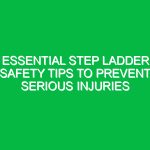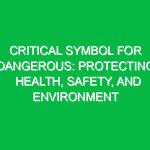Welcome Team!
Today, we’re going to dive into an essential topic that plays a crucial role in our daily operations—housekeeping Hazards. Specifically, we are focusing on the Three Types of Poor Housekeeping Hazards within the Health, Safety, and Environment (HSE) domain. These hazards not only pose risks to our Safety but can also impact productivity and workplace morale. Let’s discuss how we can identify and mitigate these hazards effectively.
Understanding Poor Housekeeping
Before we delve into the specifics, let’s clarify what we mean by “poor housekeeping.” Poor housekeeping refers to unsafe conditions that arise from lack of cleanliness and organization in the workplace. This can include cluttered work areas, improper storage of materials, and failure to clean spills promptly. It’s vital for everyone to understand that maintaining a clean and organized workspace is not just about aesthetics; it’s about Safety.
Why Focus on Housekeeping Hazards?
Engaging in this toolbox talk allows us to talk openly about safety issues that we might overlook in our daily routine. A clean environment directly influences our performance and safety. Poor housekeeping can lead to accidents, injuries, and even fatalities. By addressing the Three Types of Poor Housekeeping Hazards, we can foster a safer work environment for everyone.
Identifying the Three Types of Poor Housekeeping Hazards
Now, let’s break down the Three Types of Poor Housekeeping Hazards. Understanding these hazards will help us recognize them in our workplace and take steps to address them effectively.
1. Cluttered Work Areas
Clutter is one of the most common and dangerous hazards in the workplace. It can impede movement, create tripping hazards, and make it difficult to access emergency equipment. For example, imagine a scenario where a worker is carrying heavy materials through a cluttered area. If there are boxes, tools, or other obstructions in the way, the risk of tripping and falling increases significantly.
Best Practices to Address Clutter
- Regular Clean-up: Schedule daily or weekly clean-up times to ensure all employees contribute to maintaining a tidy workspace.
- Designated Storage: Ensure there are designated areas for tools and materials. This makes it easier to find items and ensures they are stored safely.
- Clear Pathways: Keep all walkways and emergency exits clear at all times. This is crucial for safe evacuation during emergencies.
2. Improper Storage of Materials
Improper storage can lead to various hazards, including falling objects, spills, and even Fires. For instance, if heavy items are stored on high shelves without proper restraints, they can fall, causing injuries to employees below. Similarly, hazardous materials that are not stored correctly can lead to chemical spills or reactions.
Best Practices for Proper Storage
- Follow Manufacturer Guidelines: Always adhere to the manufacturer’s instructions for storing materials, especially chemicals and flammable substances.
- Use Appropriate Containers: Ensure that all materials are stored in containers that are suitable for their properties (e.g., using spill-proof containers for liquids).
- Label Everything: Clearly label all materials and storage areas. This helps everyone understand what is stored where and the associated hazards.
3. Failure to Clean Spills Promptly
Spills, whether they are liquids or solids, can create slippery surfaces that lead to falls. Imagine a worker accidentally spilling oil on the floor and not cleaning it up right away. This not only poses a danger to that worker but to everyone else in the vicinity. Promptly addressing spills is critical to maintaining safety.
Best Practices for Spill Management
- Immediate Response: Establish protocols for quickly responding to spills. This should include having spill kits readily available in various locations.
- Training: Train employees on how to handle spills safely. This includes knowing how to use spill kits and understanding when to alert a supervisor.
- Regular Inspections: Conduct routine checks to identify potential spill hazards. This includes inspecting equipment for leaks and ensuring that materials are securely stored.
Real-Life Examples and Scenarios
Let’s take a moment to discuss some real-life scenarios that illustrate the importance of addressing these Three Types of Poor Housekeeping Hazards.
Scenario 1: Cluttered Work Areas
In a recent incident at a manufacturing facility, a worker tripped over a stack of boxes that had been left in the walkway. The fall resulted in a broken arm and significant downtime for the employee and company. This incident highlighted the need for regular clean-up protocols and ensuring that everyone understands the importance of maintaining clear walkways.
Scenario 2: Improper Storage of Materials
In another example, a construction site experienced a near-miss when a heavy toolbox fell from an improperly secured storage shelf. Fortunately, no one was injured, but it served as a wake-up call for the team to reassess their storage practices and implement proper Safety Measures.
Scenario 3: Failure to Clean Spills Promptly
A warehouse environment witnessed a significant slip and fall accident due to a spilled liquid that was left unattended. The injured employee required medical attention and the incident led to an investigation, revealing inadequate spill response Training. As a result, the company revised its spill management protocols and provided additional training to all employees.
Regulations and Standards
It’s essential to be aware of the Regulations and standards surrounding housekeeping in the workplace. Organizations like OSHA (Occupational Safety and Health Administration) provide guidelines that help ensure a safe working environment. Compliance with these regulations not only protects employees but also shields the company from potential legal liabilities.
For instance, osha mandates that employers maintain clean and orderly workplaces. Failure to comply with these regulations can result in fines and increased scrutiny from regulatory bodies. By adhering to these standards, we fulfill our legal obligations while prioritizing safety.
Open Discussion
Now that we’ve covered the Three Types of Poor Housekeeping Hazards, let’s open the floor for discussion. What challenges have you faced regarding housekeeping in your work area? Are there specific improvements you believe we can implement to enhance safety?
Conclusion
In conclusion, addressing the Three Types of Poor Housekeeping Hazards is vital to ensuring a safe and productive work environment. By recognizing and mitigating these hazards, we can prevent accidents and injuries while promoting a culture of safety. Remember, housekeeping is everyone’s responsibility.
Thank you all for your attention and commitment to safety. Let’s continue to work together to maintain a safe workplace for ourselves and our colleagues!


